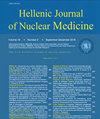The relationship between HER2 expression and 18F-FDG in gastric carcinoma.
IF 0.9
4区 医学
Q4 RADIOLOGY, NUCLEAR MEDICINE & MEDICAL IMAGING
引用次数: 0
Abstract
OBJECTIVE The aim of this retrospective study was to evaluate the relationship between human epidermal growth factor receptor 2 (HER2) expression and fluorine-18-fluorodeoxyglucose (18F-FDG) uptake in positron emission tomography with computed tomography (PET/CT) in gastric carcinoma. MATERIALS AND METHODS Gastric carcinoma patients who had 18F-FDG PET/CT scans before treatment were enrolled in this study. Ninety PET/CT images were evaluated before resection or neoadjuvant treatment of 69 patients with gastric carcinoma who had HER2 examination tests. The maximum standardized uptake value (SUVmax) at early (SUV1) and delayed images (SUV2) if any were calculated. In addition, liver SUVmax was measured from the normal liver parenchyma at the dual time (SUV1 liver and SUV2 liver). Tumor-to-liver SUVmax ratio (TLR), retention indexes (RI) from SUVmax, and TLR values obtained from dual-time images were calculated. RESULTS Histological type of 69 patients were 85.5% adenocarcinoma, 10.1% signet ring cell carcinoma, 2.9% adenosquamous carcinoma, 1.4% mucinous adenocarcinomas. Human epidermal growth factor receptor 2 negative group included 56 (81.2%) patients and the positive group had 10 (14.35%) patients. We did not find any statistical difference for the values of SUVmax and tumor-to-liver SUVmax on all histological types of gastric carcinoma on the dual-phase PET scan. High-level SUV1 was found in the HER2 positive group (8.01±3.11) than negative group (6.15±3.76) in early PET/CT imaging (P=0.043) for adenocarcinoma patients. A positive correlation was observed between HER2 and SUV1 in adenocarcinoma patients (r=0.254,P=0.042). An inverse correlation was determined for histological grade with SUV1 (r=-0.29,P=0.048), TLR1 (r=-0.29,P=0.048) and TLR2 (r=-0.324, P=0.03). CONCLUSION Patients with HER2 expression in gastric adenocarcinomas had higher SUVmax values, but no significant difference was found between the groups when the tumor/liver ratio was measured by SUVmax from normal liver parenchyma when background activity was excluded. Signet ring cell carcinoma type and the presence of the signet ring component had no effect on 18F-FDG uptake.胃癌组织中HER2表达与18F-FDG的关系。
目的回顾性研究胃癌中人表皮生长因子受体2 (HER2)表达与氟-18-氟脱氧葡萄糖(18F-FDG)摄取的关系。材料与方法治疗前进行18F-FDG PET/CT扫描的胃癌患者纳入本研究。对69例行HER2检查的胃癌患者在切除或新辅助治疗前的90张PET/CT图像进行评价。计算早期(SUV1)和延迟图像(SUV2)的最大标准化摄取值(SUVmax)。同时在正常肝实质(SUV1肝和SUV2肝)双时间测量肝脏SUVmax。计算肿瘤与肝脏的SUVmax比值(TLR)、SUVmax的滞留指数(RI)以及双时间图像获得的TLR值。结果69例患者组织学分型中腺癌占85.5%,印戒细胞癌占10.1%,腺鳞癌占2.9%,粘液腺癌占1.4%。人表皮生长因子受体2阴性组56例(81.2%),阳性组10例(14.35%)。我们在两期PET扫描中未发现所有组织学类型胃癌的SUVmax值和肿瘤到肝脏SUVmax值有统计学差异。腺癌患者早期PET/CT显像中,HER2阳性组的SUV1水平(8.01±3.11)高于阴性组(6.15±3.76)(P=0.043)。腺癌患者HER2与SUV1呈正相关(r=0.254,P=0.042)。组织学分级与SUV1 (r=-0.29,P=0.048)、TLR1 (r=-0.29,P=0.048)和TLR2 (r=-0.324, P=0.03)呈负相关。结论HER2在胃腺癌中表达较高,但在排除背景活性的情况下,用正常肝实质的SUVmax测定肿瘤/肝比值时,两组间差异无统计学意义。印戒细胞癌类型和印戒成分的存在对18F-FDG摄取没有影响。
本文章由计算机程序翻译,如有差异,请以英文原文为准。
求助全文
约1分钟内获得全文
求助全文
来源期刊
CiteScore
1.40
自引率
6.70%
发文量
34
审稿时长
>12 weeks
期刊介绍:
The Hellenic Journal of Nuclear Medicine published by the Hellenic Society of
Nuclear Medicine in Thessaloniki, aims to contribute to research, to education and
cover the scientific and professional interests of physicians, in the field of nuclear
medicine and in medicine in general. The journal may publish papers of nuclear
medicine and also papers that refer to related subjects as dosimetry, computer science,
targeting of gene expression, radioimmunoassay, radiation protection, biology, cell
trafficking, related historical brief reviews and other related subjects. Original papers
are preferred. The journal may after special agreement publish supplements covering
important subjects, dully reviewed and subscripted separately.

 求助内容:
求助内容: 应助结果提醒方式:
应助结果提醒方式:


